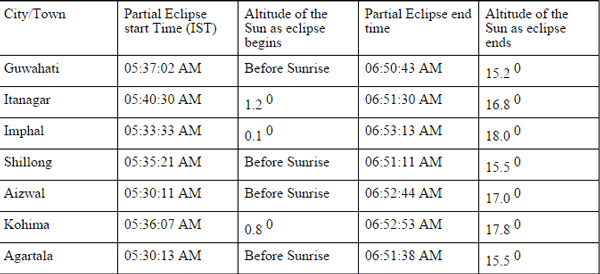Partial solar eclipse to greet India early Wednesday morning

A partial solar eclipse will be seen in India on Wednesday morning with the north-eastern parts of the country expected to see a large fraction of the disc of the Sun, eclipsed by the Moon.
The total solar eclipse, where the sun will be 100% obscured, will only be visible from parts of Indonesia including Sumatra, Borneo, and Sulawesi, and from locations in the Pacific Ocean.
Observers in north and east Australia, in South Asia, and in East Asia will be able to see a partial eclipse.
The total eclipse will begin at 04:49 AM (IST) and its maximum point will take place at 06:30 AM on March 9, 2016 before ending at 10.05 AM.
The instant of greatest eclipse occurs at 7:27 AM when the eclipse magnitude reaches 1.044 with duration of totality 4 minutes and 14 seconds in a region of Pacific Ocean.
In Delhi, people can observe the celestial phenomenon at 6:40 AM lasting for about 4 minutes.
"This is the first solar eclipse of the year and will be the only one visible until year December 26 of 2019 from India," said N Raghunandan from Planetary Society of India, Hyderabad.
The last time a solar eclipse was visible from parts of northern India was on January 4 of 2011 (Partial Solar Eclipse). The last solar eclipse visible from the entire country occurred on January 15 of 2010 (Annular Solar Eclipse), added Raghunandan.
As many parts of India are lying just at the edge of the zone of visibility of the partial phases of this eclipse, there will barely be a miniscule bite taken out of the Sun.
Further, this tiny part of the eclipse happens even as the Sun is rising, further exacerbating any viewing possibility. It is almost as if there is hardly an eclipse, to be seen, as far as most of India is concerned, said Delhi's Nehru Planetarium Director Rathnasree.
However, the real celestial traet is for India's seven sisters. In all the North Eastern states, the sunrise eclipse will be visible as a partial eclipse from within minutes of sunrise to some little time after sunrise.

However, there is a word of caution to watch the solar eclipse:
DON'TS
DOs
Partial solar eclipse to greet India early Wednesday morning - Times of India

A partial solar eclipse will be seen in India on Wednesday morning with the north-eastern parts of the country expected to see a large fraction of the disc of the Sun, eclipsed by the Moon.
The total solar eclipse, where the sun will be 100% obscured, will only be visible from parts of Indonesia including Sumatra, Borneo, and Sulawesi, and from locations in the Pacific Ocean.
Observers in north and east Australia, in South Asia, and in East Asia will be able to see a partial eclipse.
The total eclipse will begin at 04:49 AM (IST) and its maximum point will take place at 06:30 AM on March 9, 2016 before ending at 10.05 AM.
The instant of greatest eclipse occurs at 7:27 AM when the eclipse magnitude reaches 1.044 with duration of totality 4 minutes and 14 seconds in a region of Pacific Ocean.
In Delhi, people can observe the celestial phenomenon at 6:40 AM lasting for about 4 minutes.
"This is the first solar eclipse of the year and will be the only one visible until year December 26 of 2019 from India," said N Raghunandan from Planetary Society of India, Hyderabad.
The last time a solar eclipse was visible from parts of northern India was on January 4 of 2011 (Partial Solar Eclipse). The last solar eclipse visible from the entire country occurred on January 15 of 2010 (Annular Solar Eclipse), added Raghunandan.
As many parts of India are lying just at the edge of the zone of visibility of the partial phases of this eclipse, there will barely be a miniscule bite taken out of the Sun.
Further, this tiny part of the eclipse happens even as the Sun is rising, further exacerbating any viewing possibility. It is almost as if there is hardly an eclipse, to be seen, as far as most of India is concerned, said Delhi's Nehru Planetarium Director Rathnasree.
However, the real celestial traet is for India's seven sisters. In all the North Eastern states, the sunrise eclipse will be visible as a partial eclipse from within minutes of sunrise to some little time after sunrise.
However, there is a word of caution to watch the solar eclipse:
DON'TS
- Never watch the eclipse with a naked eye.
- Don't use Binoculars to view the eclipse.
- Don't use Telescope to view the eclipse.
- Don't use any cheap or easily available filters in Telescope or Binoculars to view the sun. Only specifically designed filters should be used with Telescope and Binoculars.
- Don't watch the eclipse using color film.
- Don't watch the eclipse with non-silver black and white film.
- Don't watch the eclipse with medical x-ray films with images on them.
- Don't use smoked glass to view the sun.
- All developed films lack a silver emulsion and therefore it should not be used to view the eclipse.
DOs
- You should take the advice of an experienced person or a scientist before planning to view a Total Solar Eclipse
- Only use specifically designed spectacles designed with filters to view the eclipse.
- The safest method of viewing a Total Solar Eclipse is by projection, in which a small opening is used to cast the image of the Sun on a screen beyond the opening.
- It is safe to view the total phase of an eclipse (when the moon completely coves the sun) with naked eye. But one needs to know when to stop and start viewing the total phase. So this is bit risky.
Partial solar eclipse to greet India early Wednesday morning - Times of India
